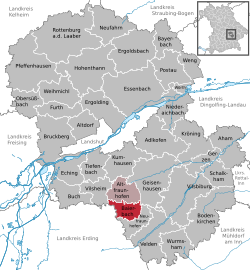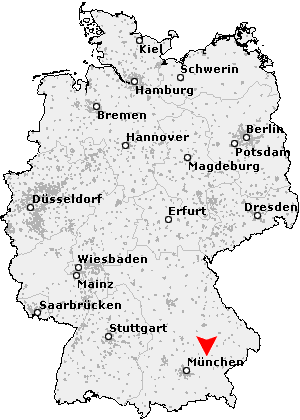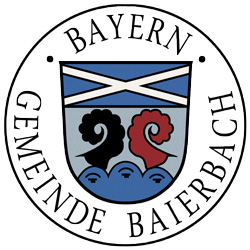Baierbach
Baierbach is a town in Lower Bavaria, Landshut district and member of the administrative community Altfraunhofen.
- 2.1 Population development
- 3.1 Coat of Arms
- 4.1 monuments
- 5.1 Economy, agriculture and forestry
- 5.2 traffic
Geography
Geographical Location
Baierbach located in the southern district of Landshut between the Great and Little Vils, about 15 km south of Landshut and 8 km north of the B 388 in Velden.
Community structure
The municipality has 36 Baierbach officially named districts:
- Aich
- Altweg
- Attenberg
- Baierbach
- Berghäusl
- Bockhub
- Edgarten
- Fahring
- Haid
- Court
- Hölzl
- Hörgenau
- Irrach
- Kastenhoibl
- Kölnberg
- Krottenthal
- Längmühl
- Maier Bach
- Moss
- Neudeck
- House of Lords Bach
- Peterau
- Reichhaid
- Reischberg
- Roth ford
- Schlott
- Sindhub
- Steinbach
- Stroblstetten
- Theobald
- House of Bach
- Vorderhoibl
- Pond
- Wim
- Wimbauer
Neighboring communities
- Altfraunhofen
- Geisenhausen
- Neufraunhofen
- Hohenpolding ( district of Erding )
- Vilsheim
History
Between 857 and 864 gave Bishop Anno of Freising to the noble Hrudoldus Purgipach in a church along with Belongings and three serfs in exchange for a yard with three serfs to Schweinbach. The name Purgipach indicates the presence of a castle.
It was a royal estate, because the Frankish king gave to this exchange his express permission. In the 10th century, Emperor Otto I. gave to the monastery Niedermünster in Regensburg.
In the 14th century the place is called Pewerbach, Pivrbach and Pevrbach, then Pewrpach, Hofpeurpach, 1739 Beurbach and only since 1811 Baierbach.
Since the beginning of the 15th century here built the Barons of Frauenhofen to their imperial rule. Besides Altfraunhofen, Upper Heldenberg, Holzhausen and Neufraunhofen Baierbach was one of the five chairman machinations of this territory. The local legal issues were always controversial, as the Electorate of Bavaria, the imperial immediacy of the Barons of Frauenhofen not recognized.
With the Act of Confederation, the area came in 1806 to Bavaria. In the course of administrative reform in Bavaria was the first municipality edict of 1808, the tax district Baierbach in patrimonial Neufraunhofen and the second municipality of 1818, the municipality in the district court Baierbach Vilsbiburg. In the control district court only Fraunhofersche Holden were present, so the community was indirectly fraunhofisch. The rule of court Frauenhofen persisted until the abolition of patrimonial in 1848.
Population Development
On the territory of the municipality in 1970 was only 607, 1987, 606 and then counted 736 inhabitants in 2000. On 30 March 2011, there were then already 816 inhabitants ( of which 418 are male, 398 female, 660 Catholic, 34 Protestant).
Policy
Mayor 's House Luise Berger (CSU ).
Coat of arms
The coat of arms shows run since 1983 under blue shield main, is a silver St. Andrew's Cross, in silver over blue Dreienberg a black front, rear thereof facing away from red ram's horn.
The St. Andrew's cross in chief points to the St. Andrew's patronal feast of the parish church. The lower part of the coat of arms with the two ram's horns over the three mountain remembered as a (false ) image canting Family Wi ( e) DERS pacher in the 17th century had the right of presentation to the benefice of the Frauenkirche in Baierbach. The benefice was later transferred to the parish church of St. Andrew.
Culture and sights
- Parish Church of St. Andrew. The late Gothic church was built in the second half of the 15th century. It was enlarged in 1888.
- In addition to Church of Our Lady. The brick building from the second half of the 15th century has a net vault. In the high altar carved figures are from Christian Jorhan the Elder to in 1760.
Monuments
→ List of monuments in Baierbach
Economy and infrastructure
Economy, agriculture and forestry
It was in 1998 according to official statistics in the manufacturing sector and 40 in the area of trade and transport 10 persons work at the workplace. Social insurance contributions at residence, there were a total of 220 in the manufacturing sector, there were five farms, in construction 2 companies. In addition, in 1999, there were 35 farms with an agricultural area of 973 ha, of which 838 ha of arable land.
As of March 30, 2011, community is debt free.
Traffic
The local roads are 28.74 km long.
Clubs
- Altschützengesellschaft Baierbach
- CSU Ortsverband Baierbach
- Volunteer Fire Baierbach
- Borderland Protect Steinbach
- Jungschützen Baierbach
- Warriors and Soldiers camaraderie Baierbach
- Horticultural Association Baierbach
- TSV Baierbach 1968 e.V.








